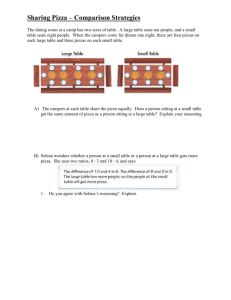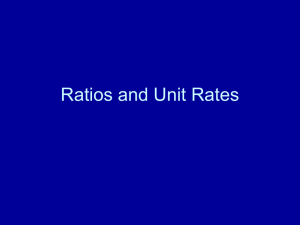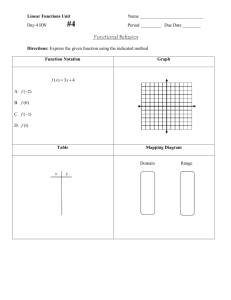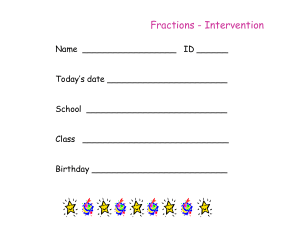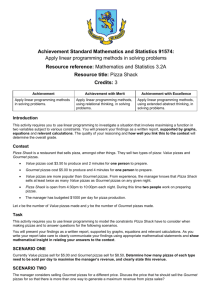Laboratory No. 2 - Faculty of Computer Science
advertisement
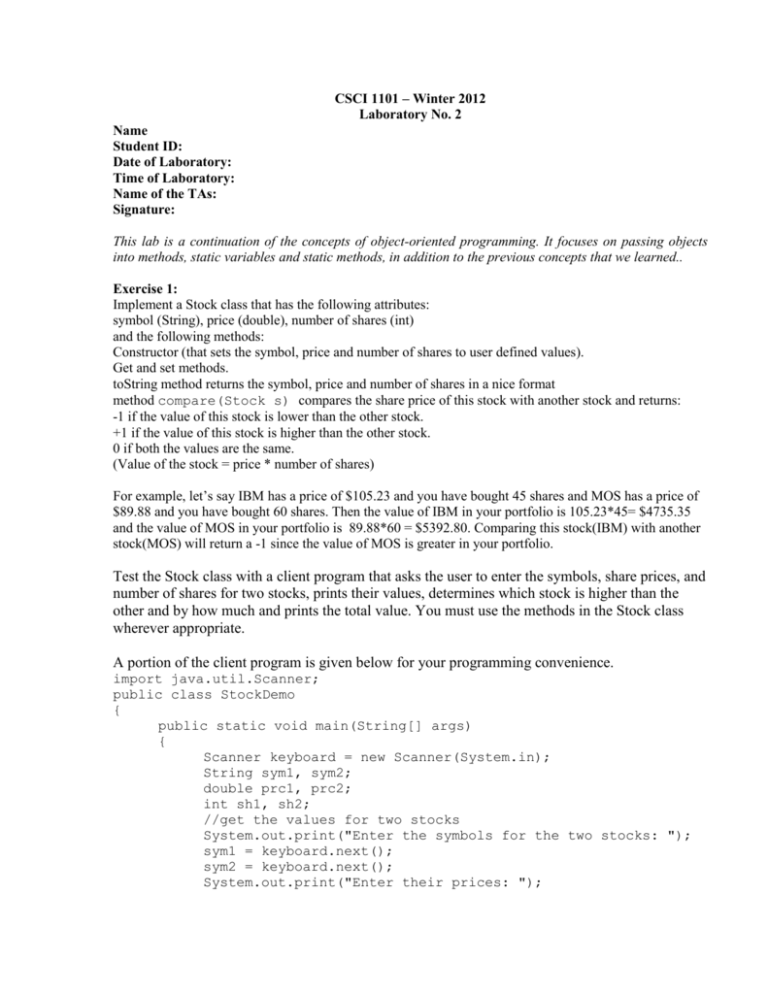
CSCI 1101 – Winter 2012
Laboratory No. 2
Name
Student ID:
Date of Laboratory:
Time of Laboratory:
Name of the TAs:
Signature:
This lab is a continuation of the concepts of object-oriented programming. It focuses on passing objects
into methods, static variables and static methods, in addition to the previous concepts that we learned..
Exercise 1:
Implement a Stock class that has the following attributes:
symbol (String), price (double), number of shares (int)
and the following methods:
Constructor (that sets the symbol, price and number of shares to user defined values).
Get and set methods.
toString method returns the symbol, price and number of shares in a nice format
method compare(Stock s) compares the share price of this stock with another stock and returns:
-1 if the value of this stock is lower than the other stock.
+1 if the value of this stock is higher than the other stock.
0 if both the values are the same.
(Value of the stock = price * number of shares)
For example, let’s say IBM has a price of $105.23 and you have bought 45 shares and MOS has a price of
$89.88 and you have bought 60 shares. Then the value of IBM in your portfolio is 105.23*45= $4735.35
and the value of MOS in your portfolio is 89.88*60 = $5392.80. Comparing this stock(IBM) with another
stock(MOS) will return a -1 since the value of MOS is greater in your portfolio.
Test the Stock class with a client program that asks the user to enter the symbols, share prices, and
number of shares for two stocks, prints their values, determines which stock is higher than the
other and by how much and prints the total value. You must use the methods in the Stock class
wherever appropriate.
A portion of the client program is given below for your programming convenience.
import java.util.Scanner;
public class StockDemo
{
public static void main(String[] args)
{
Scanner keyboard = new Scanner(System.in);
String sym1, sym2;
double prc1, prc2;
int sh1, sh2;
//get the values for two stocks
System.out.print("Enter the symbols for the two stocks: ");
sym1 = keyboard.next();
sym2 = keyboard.next();
System.out.print("Enter their prices: ");
prc1 = keyboard.nextDouble();
prc2 = keyboard.nextDouble();
System.out.print("Enter the number of shares for the two
stocks: ");
sh1 = keyboard.nextInt();
sh2 = keyboard.nextInt();
//create the first Stock
Stock s1 = new Stock(sym1,prc1,sh1);
//create the second Stock
Stock s2 = new Stock(sym2,prc2,sh2);
// continue the rest of the code here
The following is a sample screen dialog:
Enter the symbols for the two stocks: IBM MOS
Enter their prices: 105.23 89.88
Enter the number of shares for the two stocks: 45 60
I have the following stocks:
Stock: IBM
Price: 105.23
Shares: 45
Stock: MOS
Price: 89.88
Shares: 60
The value of MOS is higher than IBM by $ 657.45
The total value of my portfolio is $ 10,128.15
Process completed.
Exercise 2: Implement the Point class (basic Point class was discussed in the lecture). The class has the
following instance variables:
x coordinate
y coordinate
and the following methods:
Constructor that sets the x and y coordinates
Get and set methods
Method equals if this point is equal to another point object (if the x and y coordinates are the
same).
Method isHigher if this point is higher than another point object (if the y coordinate of this point is
greater than the y coordinate of the other point)
Method findLength that calculates the length of the line connecting this point to another point
object. (Formula for length between two points (x1,y1) and (x2,y2) is square root of ((x2-x1)2 +
(y2-y1)2)
Test the class. In the demo program, construct four points p1, p2, p3 and p4 using user-defined values.
Determine
Which point is the highest. (If two points are at the same height, you may report either point).
Whether line p1 p2 is longer than line p3 p4.
A sample screen dialog is given below:
Enter the x and y coordinates
Enter the x and y coordinates
Enter the x and y coordinates
Enter the x and y coordinates
[-9,7] is the highest point
The length between [-9,7] and
The length between [4,-3] and
Line from [-9,7] to [5,-7] is
for
for
for
for
point1:
point2:
point3:
point4:
-9 7
5 -7
4 -3
0 -2
[5,-7] is 19.79898987322333
[0,-2] is 4.123105625617661
longer
Exercise 3 (a) : This is also an example that we discussed in class. Implement and test the following
program. Trace the output so that you understand the operation of the program.
public class TurnTaker
{
private static int turn = 0;
private int myTurn;
private String name;
public TurnTaker(String n, int t)
{
name = n;
myTurn = t;
}
public String getName()
{
return name;
}
public static int getTurn()
{
turn++;
return turn;
}
public boolean isMyTurn()
{
if (turn==myTurn)
return true;
else
return false;
}
}
public class TurnTakerDemo
{
public static void main(String[] args)
{
TurnTaker person1 = new TurnTaker("Romeo", 1);
TurnTaker person2 = new TurnTaker("Juliet", 3);
for(int i = 1; i<= 5; i++)
{
System.out.println("Turn = " + TurnTaker.getTurn());
if (person1.isMyTurn())
System.out.println("Love from "+ person1.getName());
if (person2.isMyTurn())
System.out.println("Love from " + person2.getName());
}
}
}
Exercise 3(b): Modify the program so that you get the following output:
Turn
Love
Love
Turn
Love
Love
Turn
Love
Love
Turn
Love
Love
Turn
Love
Love
= 1
from
from
= 2
from
from
= 3
from
from
= 4
from
from
= 5
from
from
Romeo
Juliet
Romeo
Juliet
Romeo
Juliet
Romeo
Juliet
Romeo
Juliet
Exercise 4: Chuck owns several pizza stands distributed throughout town. You are the java expert who
will help Chuck keep track of the number of pizzas sold by the stand as well as the total number of pizzas
sold in all the stands. For this, define a class named PizzaStand that has an instance variable for the Pizza
Stand’s ID number and an instance variable for how many pizzas sold in that stand that day. Add a static
variable that tracks the total number of pizzas sold by all the stands. Add another static variable that
specifies the cost per pizza.
Add the following methods:
A constructor that sets the ID number to some value and the number of pizzas sold by that stand to 0.
A method named justSold that increments the number of pizzas sold by that stand by 1.
Another method to return the number of pizzas sold by that stand.
A static method to set the cost per pizza.
A static method that returns the total number of pizzas sold by all stands.
A static method to return the total sales.
Test the class with at least five pizza stands that each sell a number of pizzas during the day.
A sample screen dialog is given below. The cost of the pizza is set to $5.00.
Pizza Sales:
1
2
(means that Pizza Stand 1 sold 2 pizzas)
2
1
3
1
4
1
5
1
Total pizzas sold: 6
Total sales: 30.0
Process completed.
